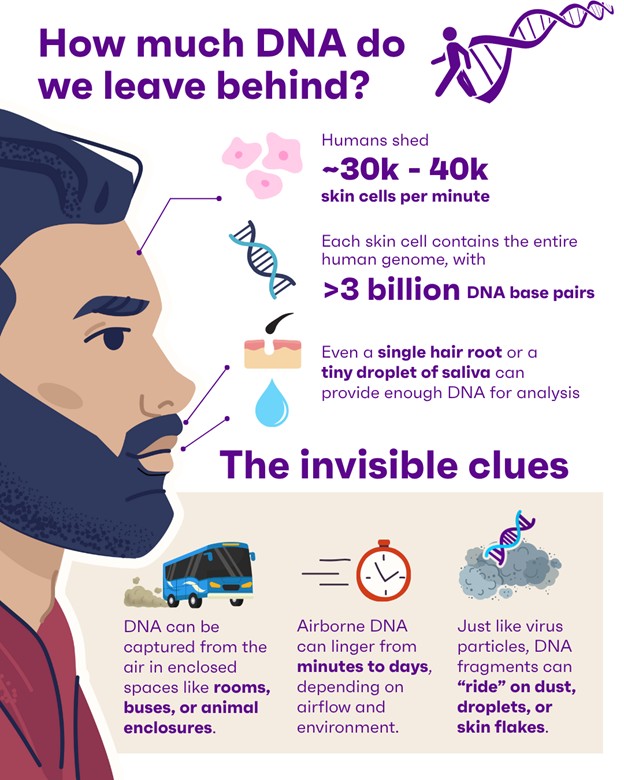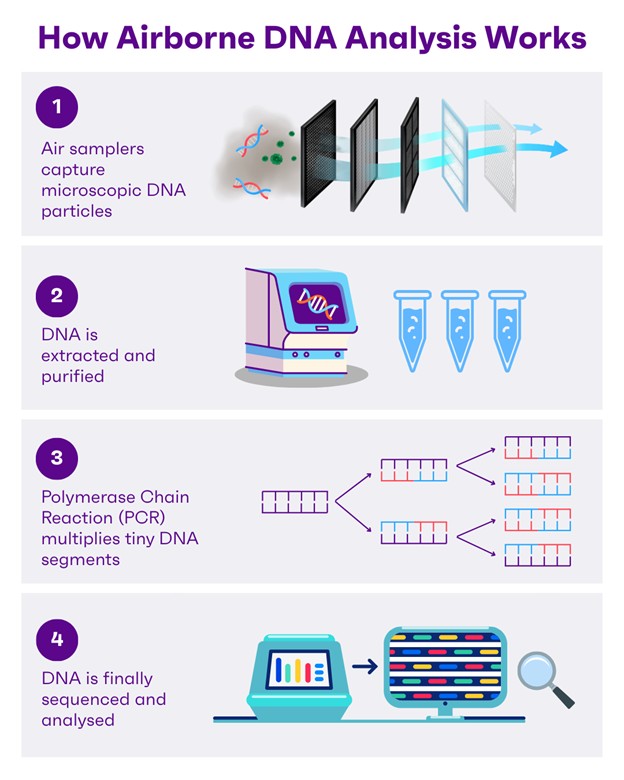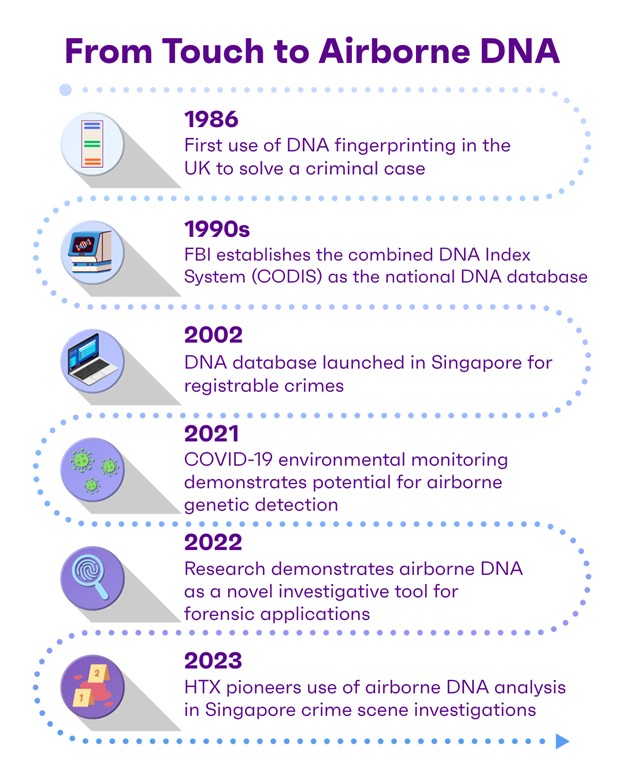 Airborne DNA analysis can help investigators when there’s little physical evidence to work with. (Photo: Freepik)
Airborne DNA analysis can help investigators when there’s little physical evidence to work with. (Photo: Freepik)
For over a century, investigators have relied on physical clues left behind at crime scenes – fingerprints, bodily fluids, stray hairs.
Relying on visible evidence, however, isn’t foolproof. Just consider the perpetrators who remove traces of evidence by sanitising crime scenes.
But what if the very air we breathe could provide investigative leads?
In Singapore, HTX is pioneering the use of airborne DNA analysis, a groundbreaking forensic technique that allows scientists to capture and analyse human DNA lingering in the air – thereby providing crucial investigative leads even in the most challenging scenarios.
Why do we need this technology?
 (Infographic: HTX/Nicole Lim)
(Infographic: HTX/Nicole Lim)
Contrary to heavily dramatised crime shows, the biological samples at a crime scene don’t always yield useful information. For one, environmental factors can degrade DNA, making it unsuitable or difficult to analyse.
Airborne DNA analysis helps to broaden the evidence net by tapping into a persistent yet previously often inaccessible (due to technical limitations) source of evidence: the trace DNA we constantly shed through skin cells, hair and respiratory droplets.
Jamie Mong, a Senior Forensic Scientist at HTX’s Forensics Centre of Expertise (CoE), explained that the scientific approach is especially valuable in two types of crime scenes: those where physical evidence is scarce and those where it is widespread.
In the latter, airborne DNA analysis works alongside traditional evidence collection to give investigators a comprehensive view of the scene, in a fraction of the time required by traditional extensive sampling.
“An air sample can be obtained in around two hours,” she said. “Airborne DNA represents an additional investigative tool that can be deployed when scene conditions warrant enhanced evidence collection methods – particularly in high-stakes investigations such as homicides or terrorist attacks.”
Capturing and analysing airborne DNA
 (Infographic: HTX/Nicole Lim)
(Infographic: HTX/Nicole Lim)
The process of collecting and analysing airborne DNA involves several key stages.
First, specialised air samplers are deployed at the crime scene. Jamie explained that her team uses high-efficiency air samplers, similar to those used to detect airborne viruses during the COVID-19 pandemic. These samplers employ filters to capture microscopic DNA particles suspended in the air.
She added that the sampling strategy itself is highly dependent on the environment. Factors such as whether the sampling is indoors or outdoors, the size of the room, ventilation patterns and temperature all influence how and where the samplers are placed to ensure optimal evidence retrieval.
Next, the samplers are transported back to the laboratory, where the captured DNA is carefully extracted from the filters and purified. This intricate process involves breaking down cells and other biological material to release the DNA, and separating it from any contaminants to obtain a pure sample for analysis.
Then, the extracted DNA, often in minute quantities, is amplified using Polymerase Chain Reaction (PCR), a laboratory technique that creates multiple copies of specific DNA segments. This enables scientists to generate a usable DNA profile even from degraded or limited DNA material.
Finally, the amplified DNA is sequenced to obtain a profile which can be compared against a DNA database or to a suspect’s DNA profile.
Overcoming the challenges
 (Infographic: HTX/Nicole Lim)
(Infographic: HTX/Nicole Lim)
While promising, airborne DNA analysis faces inherent challenges.
Jamie explained that airborne DNA can exist in low concentrations and – like DNA from traditional biological samples – is vulnerable to degradation from temperature, humidity and UV exposure. Distinguishing between relevant DNA and background DNA from unrelated individuals can also be complex.
To this end, HTX is actively addressing these challenges through various research initiatives. These include optimising collection methods for maximum DNA yield; refining DNA extraction and amplification protocols for degraded samples; developing advanced analysis algorithms to differentiate between relevant and background DNA, and conducting research on how Singapore's tropical climate impacts the length of time DNA remains detectable.
"Singapore's unique combination of high humidity, year-round high temperatures and extensive use of air-conditioning creates distinct conditions that must be understood,” explained Jamie.
“Studying these local environmental impacts is crucial to ensure our scientific methods remain reliable and applicable in our tropical urban context."
The future of forensic science
 Airborne DNA analysis has multiple applications beyond crime scene investigation. (Photo: Freepik)
Airborne DNA analysis has multiple applications beyond crime scene investigation. (Photo: Freepik)
Airborne DNA analysis holds immense potential beyond crime scene investigation. For example, it could be used to investigate security breaches at sensitive locations, by applying similar forensic principles as environmental genetic detection for viruses such as COVID-19.
In disaster zones, it could identify victims trapped under rubble. It could potentially even contribute to environmental monitoring by tracking the movement of individuals or populations for public safety.
While still in its early stages, airborne DNA analysis represents a paradigm shift in forensic science. HTX's work in this field is paving the way for a future where the air we breathe can help better safeguard our nation.

